Toyota Allion
| Toyota Allion | |
|---|---|
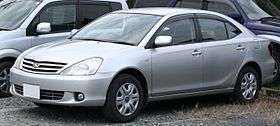 Toyota Allion (first generation) | |
| Overview | |
| Manufacturer | Toyota |
| Also called | Toyota Premio |
| Production | 2001–present |
| Body and chassis | |
| Class | Compact car |
| Body style | 4-door sedan |
| Chronology | |
| Predecessor |
|
The Toyota Allion and similar Toyota Premio are sedans sold in Japan since 2001 by Toyota. The sedans are as designated as compact by Japanese regulations concerning exterior dimensions and engine displacement. The Allion is exclusive to Japanese Toyota dealerships Toyota Store, while the Premio is exclusive to Toyopet Store locations. Both cars are related to the Toyota Avensis, which is exclusive to Toyota Netz locations.
Both the Premio and the Allion were introduced at the same time. The Premio is an upscale, and more luxurious sedan in comparison to the Allion, which has a more youthful, and sporting nature. Wood trim and silver accents gives the Premio an elegant look and it is considered to be a family or executive type car. Appearance modification options made for the Allion are not made or marketed for the Premio.
The name "Allion" is created based on the phrase "all-in-one".
In terms of class, the Allion and Premio are designed to serve as an alternative to the Toyota Camry, which is exclusive to the Toyota Corolla Store locations.
First generation (T240; 2001–2007)
| First generation (T240) | |
|---|---|
 2001–2004 Toyota Allion | |
| Overview | |
| Production | 2001–2007 |
| Assembly | Japan |
| Designer | Hiroshi Okamoto (Allion)[1] |
| Body and chassis | |
| Body style | 4-door sedan |
| Layout | |
| Related | Toyota Caldina (T240) |
| Powertrain | |
| Engine | |
| Transmission | |
| Dimensions | |
| Wheelbase | 2,700 mm (106.3 in) |
| Length | 4,565 mm (179.7 in) |
| Width | 1,695 mm (66.7 in) |
| Height | 1,470 mm (57.9 in) |
| Curb weight | 1,170 kg (2,580 lb) |
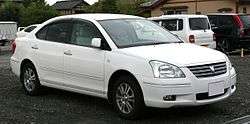

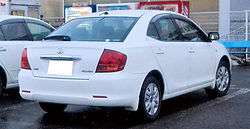

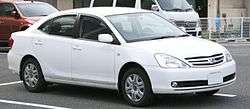
The first generation Allion and Premio were launched on 25 December 2001. The Allion replaced the Toyota Carina, a model that first appeared in 1970. The Premio is the successor of the Toyota Corona and the Corona Premio.
The Allion has an emphasis towards younger buyers in comparison to the Premio sedan, which has a more elegant approach. The Premio and the Allion share the same engines and interior. The Allion can be customized with front spoilers and rear mounted trunk wings, as well as ground effect body parts to enhance the vehicles appearance specially designed and sold by Toyota. The Allion also features rear tilting seats (similar to front seats). The Allion continues the Toyota tradition by being made for taxi usage, driving school and law enforcement versions.
On 20 December 2004, the Allion received a modest restyle with the introduction of LED taillights. The Premio also received an update at the same time.
Both cars were offered with three engine sizes; 1.5-, 1.8- and 2.0-liter. The 2.0-liter model received a CVT automatic; the smaller engines were each fitted with four-speed automatic transmission.
Second generation (T260; 2007–present)
| Second generation (T260) | |
|---|---|
 2007–2010 Toyota Allion | |
| Overview | |
| Production | 2007–present |
| Assembly | Japan: Toyota, Aichi (Tsutsumi plant)[2] |
| Body and chassis | |
| Body style | 4-door sedan |
| Layout | |
| Powertrain | |
| Engine | |
| Transmission | CVT automatic |
| Dimensions | |
| Wheelbase | 2,750 mm (108.3 in) |
| Length | 4,565 mm (179.7 in) |
| Width | 1,695 mm (66.7 in) |
| Height | 1,475 mm (58.1 in) |
| Curb weight | 1,440 kg (3,170 lb) |
_1.5F_sedan_(2016-01-07)_01.jpg)
_1.5F_sedan_(2016-01-07)_02.jpg)
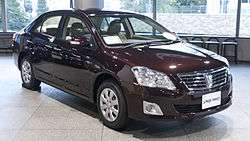
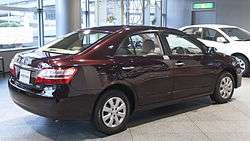



The second generation Allion and Premio were introduced on 4 June 2007, with Toyota continuing to offer appearance modifications at local dealerships. These cars continued to fill the gap between Corolla and Camry. G-BOOK is on the list of optional features. The Premio gained the inclusion of a LED in the rear lamp cluster. Other changes included the smart entry and start system, a rear-view monitor in color, and a hard disk navigation system compatible with the G-Book mX telematics service.[3]
Four-wheel drive was offered on vehicles equipped with the 1.8-liter 2ZR-FE direct-injection engine. A 2.0-liter valvematic 3ZR-FAE engine was made available in January 2008, cutting the emission by 75 percent from the level required by the 2005 Japanese emission standards, and also achieving 20 percent better fuel economy than required by the 2010 fuel consumption standards. The transmission was a Super CVT-i.[3]
Fuel consumption figures for the 1.5-liter models were improved to 18 km/L (42 mpg-US; 51 mpg-imp), and the 1.8-liter models were improved to 17 km/L (40 mpg-US; 48 mpg-imp), both types now fitted with CVT transmission. From 2 October 2009, fuel consumption for the 1.5-liter models was further improved to 18.6 km/L (44 mpg-US; 53 mpg-imp) by improvements to the engine, transmission and alternator control.
In April 2010, the 1.8-liter engine changed from the 2ZR-FE to the Valvematic 2ZR-FAE, improving fuel consumption to 18.6 km/L (44 mpg-US; 53 mpg-imp). In June 2010, fuel consumption for the 1.5-liter models was improved to 20 km/L (47 mpg-US; 56 mpg-imp) by improvements to engine and transmission control.
The Allion was again restyled in 2010 with more aggressive and sharper looking headlights and twin LED tail lights while the interior remaining somewhat same.
Facelift (2016)

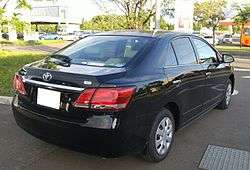

Toyota revised the Premio and Allion again on 13 June 2016 with a facelift. At the same time, "bi-beam" LED headlights and the collision avoidance system called "Toyota Safety Sense C" were introduced, adopting a styling influence from the larger, more prestigous S210 Crown.
References
- ↑ "岡本浩志" [Okamoto Hiroshi] (in Japanese). Chiba University. 2006. Retrieved 2016-06-21.
- ↑ "Japanese Production Sites". Toyota. 2015-03-06. Archived from the original on 2015-03-18.
- 1 2 "75 Years of TOYOTA | Vehicle Lineage | Allion". Toyota. 2007-06-04. Retrieved 2015-08-06.
External links
| Wikimedia Commons has media related to |